What Are Hydrophytes: Information About Hydrophyte Habitats


What are hydrophytes? In general terms, hydrophytes (hydrophytic plants) are plants that are adapted to survive in oxygen-challenged aquatic environments.
Hydrophyte Facts: Wetland Plant Info
Hydrophytic plants have several adaptations that allow them to survive in water. For example, water lilies and lotus are anchored in the soil by shallow roots. The plants are equipped with long, hollow stems that reach the surface of the water, and large, flat, waxy leaves that allow the top of the plant to float. The plants grow in water as deep as 6 feet (2 m.). Other types of hydrophytic plants, such as duckweed or coontail, are not rooted in the soil; they float freely on the surface of the water. The plants have air sacs or large spaces between the cells, which provide buoyancy that allows the plant to float on top of the water. Some types, including eelgrass or hydrilla, are completely submerged in water. These plants are rooted in the mud.
Hydrophyte Habitats
Hydrophytic plants grow in water or in soil that is consistently wet. Examples of hydrophyte habitats include fresh or salt water marshes, savannahs, bays, swamps, ponds, lakes, bogs, fens, quiet streams, tidal flats, and estuaries.
Hydrophytic Plants
Hydrophytic plant growth and location depends on a number of factors, including climate, water depth, salt content, and soil chemistry. Plants that grow in salt marshes or along sandy beaches include:
- Seaside plantain
- Sea rocket
- Salt marsh sand spurrey
- Seaside arrowgrass
- High tide bush
- Salt marsh aster
- Sea milwort
Plants that commonly grow in ponds or lakes, or in marshes, swamps, or other areas that are flooded by at least 12 inches (31 cm.) of water for most of the year include:
- Cattails
- Reeds
- Wild rice
- Pickerelweed
- Wild celery
- Pond weeds
- Buttonbush
- Swamp birch
- Sedge
Several interesting carnivorous plants are hydrophytic, including sundew and northern pitcher plant. Orchids that grow in hydrophytic environments include white-fringed orchid, purple-fringed orchid, green wood orchid, and rose pogonia.
Gardening tips, videos, info and more delivered right to your inbox!
Sign up for the Gardening Know How newsletter today and receive a free download of our most popular eBook "How to Grow Delicious Tomatoes."

A Credentialed Garden Writer, Mary H. Dyer was with Gardening Know How in the very beginning, publishing articles as early as 2007.
-
 How To Get Rid Of Mosquitoes In The Garden: 9 Natural Ways To Make Them Buzz Off!
How To Get Rid Of Mosquitoes In The Garden: 9 Natural Ways To Make Them Buzz Off!How to get rid of mosquitoes is on the minds of people in the summer in almost every region of the world. Learn how to repel the pests without toxic chemicals.
By Mary Ellen Ellis
-
 Monkey Orchid Care: How To Grow This Fascinating Species
Monkey Orchid Care: How To Grow This Fascinating SpeciesThe monkey orchid (Dracula simia) bears a remarkable resemblance to its namesake and, with a little know-how, can be successfully grown as a houseplant.
By Bonnie L. Grant
-
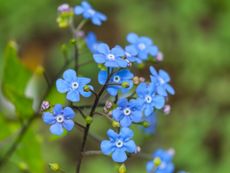 Flowering Pond Plants - Growing Aquatic Flowers
Flowering Pond Plants - Growing Aquatic FlowersAdding flowering pond plants to natural and manmade water features can be an easy way to quickly beautify a space with lush greenery and vibrant bursts of seasonal color. Read on for more.
By Tonya Barnett
-
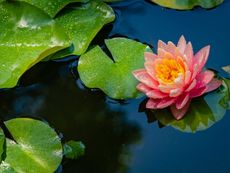 Full Sun Aquatic Plants - Full Sun Floating Pond Plants
Full Sun Aquatic Plants - Full Sun Floating Pond PlantsThere are pros and cons to putting a pond in full sun, but it's very doable. Here are some ideas to get you started.
By Mary Ellen Ellis
-
 Echinodorus Creeping Burhead – Information On Creeping Burhead Plant Care
Echinodorus Creeping Burhead – Information On Creeping Burhead Plant CareCreeping burhead plants are members of the water plantain family and commonly used in freshwater aquariums or outdoor fishponds. Echinodorus creeping burhead is native to the eastern half of the United States. To learn more about the creeping burhead plant click the following.
By Laura Miller
-
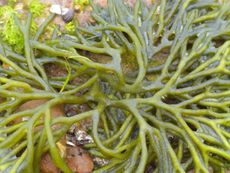 What Is A Saltwater Aquarium: Plants For Saltwater Aquariums
What Is A Saltwater Aquarium: Plants For Saltwater AquariumsBuilding and maintaining a saltwater aquarium requires some expert knowledge in choosing the right plants. Here are some choices to start with.
By Mary Ellen Ellis
-
 Outdoor Aquarium Ideas: Putting A Fish Tank In The Garden
Outdoor Aquarium Ideas: Putting A Fish Tank In The GardenAquariums are generally made for inside the house, but why not have a fish tank outside? Click here for tips and ideas on backyard aquariums.
By Mary Ellen Ellis
-
 Fish That Eat Plants – Which Plant Eating Fish Should You Avoid
Fish That Eat Plants – Which Plant Eating Fish Should You AvoidGrowing plants with aquarium fish is rewarding, but if you want to combine plants and fish, learn what aquarium fish to avoid. This article will help.
By Mary H. Dyer
-
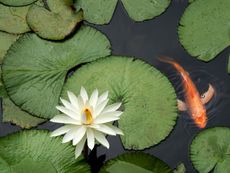 Is Pond Fertilizer Bad For Fish: Learn About Fish Safe Fertilizer
Is Pond Fertilizer Bad For Fish: Learn About Fish Safe FertilizerUsing fertilizer around fishponds must be done with care. Excess nitrogen causes algae, but can also contaminate the water and affect fish. Learn more here.
By Bonnie L. Grant
-
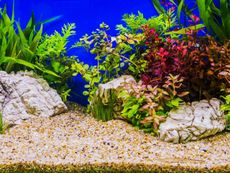 What Is Aquascaping – Creating An Aquarium Garden
What Is Aquascaping – Creating An Aquarium GardenAquatic gardening can be a rewarding endeavor, especially when aquascaping. Click this article to learn more about creating an aquarium garden.
By Nikki Tilley